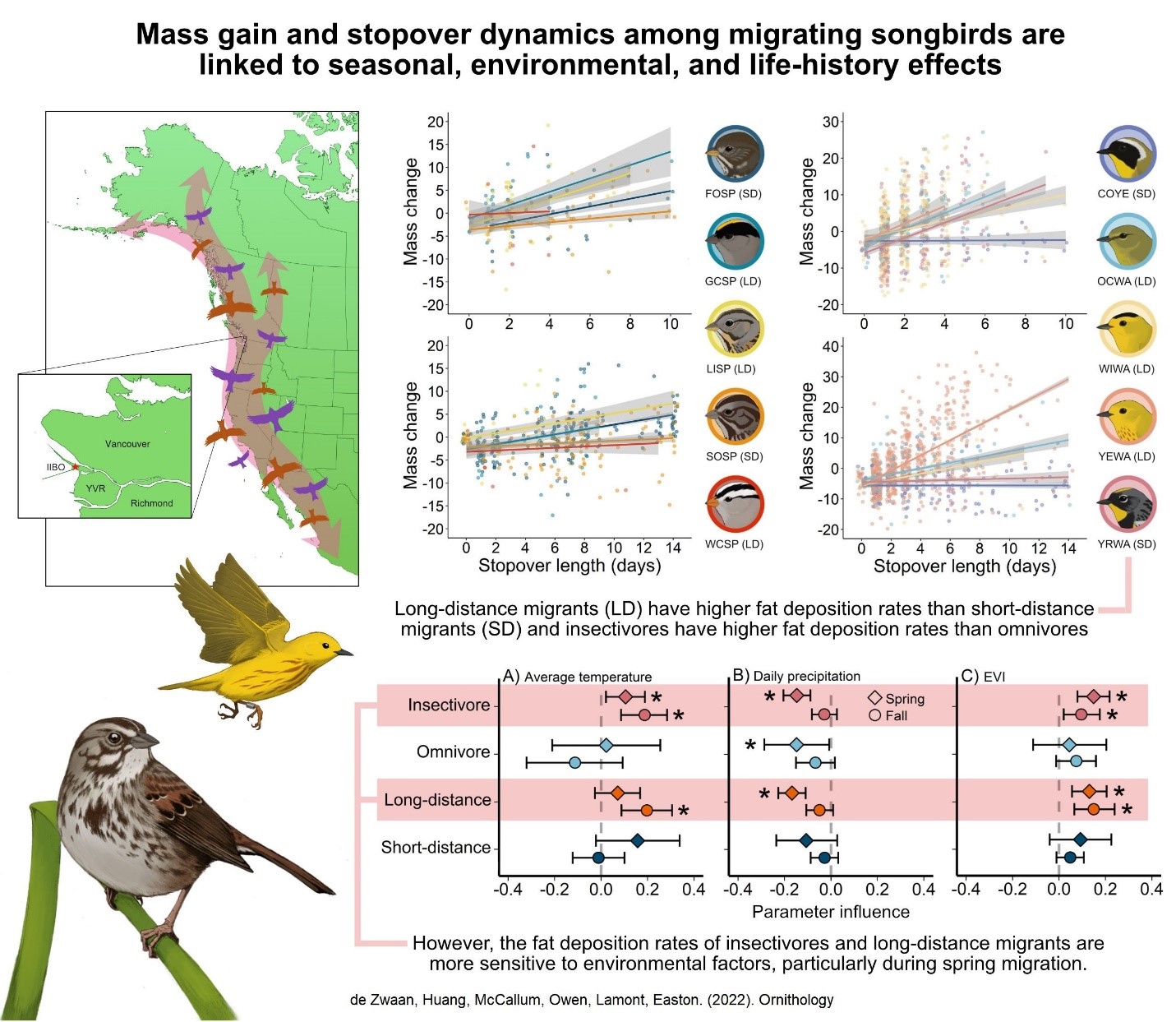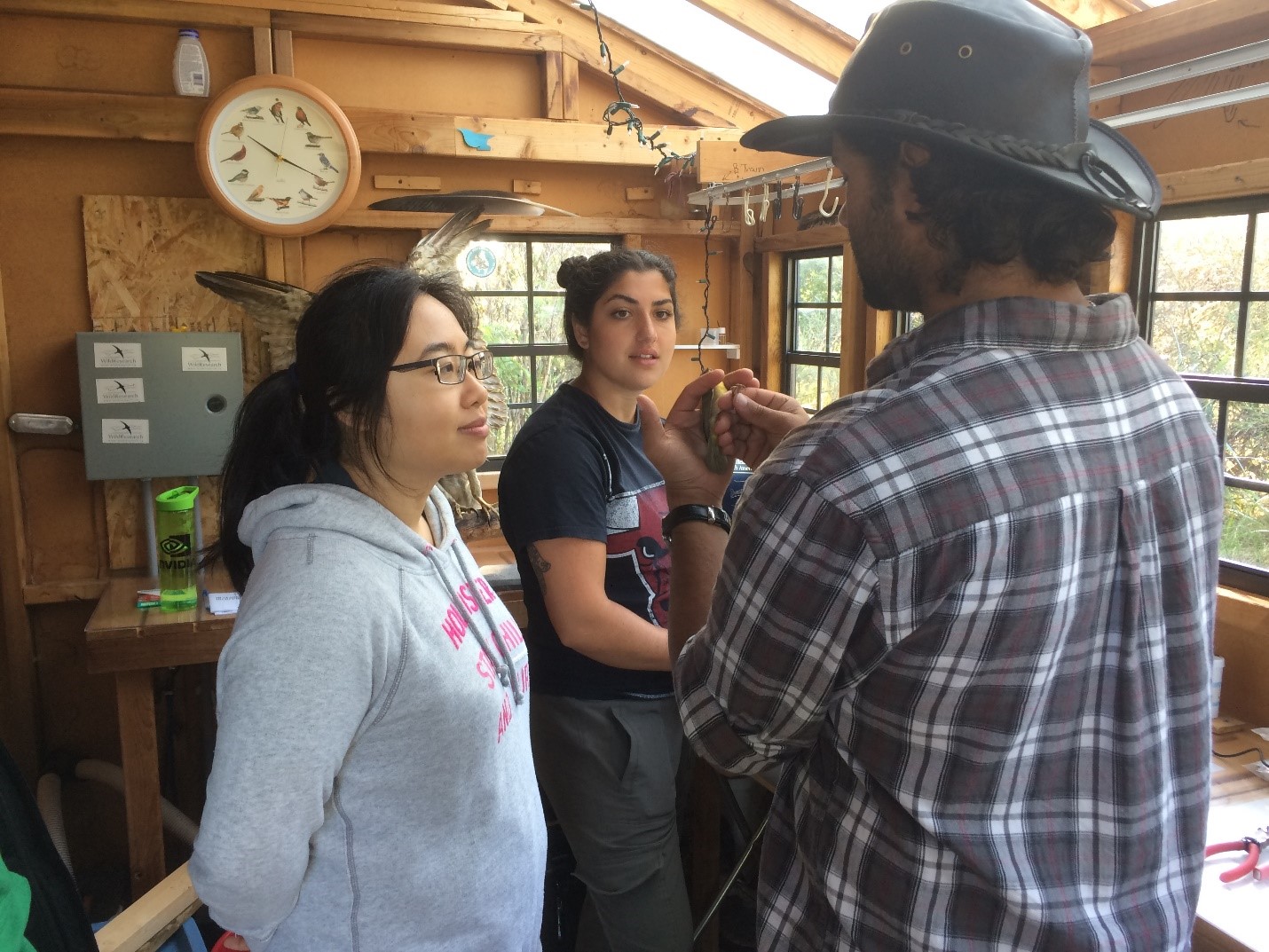By Andrew Huang, Kiirsti Owen, and Dr. Devin R. de Zwaan
Each spring and fall, the sky is brimming with literally billions of migratory birds. During their arduous journey, birds need to make stops along the way to refuel by packing on the grams. Gorging on insects, seeds, and berries, birds accumulate massive amounts of body fat – up to 50% of their body mass – as fat is the primary energy supply that fuels their high-endurance migrations. It’s no surprise then that stopover habitats are a critical component of successful migration, and therefore should receive more conservation attention than they currently do. However, what do “high quality” migration stopover sites look like, and how does one evaluate quality?
The banding hut at Iona Island Bird Observatory with volunteers setting up outside. The wood lot is a successional deciduous forest patch that supports an abundance of insect-eating birds during migration. Photo credit: Kiirsti Owen.
Using a 10-year dataset collected from the Iona Island Bird Observatory (IIBO) – a bird banding station operated by WildResearch and situated in the southwest corner of British Columba – we investigated the ecological processes that shape the stopover dynamics of five warbler and five sparrow species. More specifically, we wanted to understand how season, dietary guild, and migration strategy influenced mass gain, and how, in turn, these factors influenced stopover length. We found that, in general, birds staying at Iona Island gained mass by building fat reserves at a high daily rate, but that this rate varied among species and seasons. Mass gain was particularly pronounced during the spring, for insectivorous birds (warblers), and importantly for long-distance migrants (Orange-crowned Warbler, Yellow Warbler, Wilson’s Warbler, Lincoln’s Sparrow, and White-crowned Sparrow). Our findings also showed that birds that were fatter upon arrival departed sooner, whereas lighter individuals remained longer, likely to recover their depleted fat reserves. The warblers and sparrows in our study may therefore need to reach a certain mass threshold before they continue their migration journey. In fact, mass was a stronger predictor of departure probability than weather during spring migration when birds are in a particular rush to get to their breeding grounds.
Two of the most commonly-captured species at the banding station: Yellow-rumped Warbler (left), a short-distance migrant. Yellow Warbler (right), a long-distance migrant. Photo credit: Andrew Huang
Our study provides strong evidence for Iona Island’s role as a high-quality stopover site for birds migrating along the Pacific Flyway. We see that at Iona Island: 1) migrants that stick around longer put on more weight through fat gain, 2) long-distance migrants can refuel at a high rate, and 3) migrants in energetic distress can recoup fuel deficits quickly. Despite being surrounded by metropolitan centres and intensive agriculture, Iona Island represents a mosaic of brackish wetland, reed beds, and deciduous forest patches – the ideal stopover habitat for migratory birds, particularly insectivorous species. As its name suggests, Iona Island may represent an “ecological island” in which to stopover within a regional matrix of sub-optimal habitat. Protecting these critical stopover sites is a key part of any bird conservation strategy.
Lastly, endless THANK-YOUs to all the WildResearch volunteers and supporters! Without their devoted time and funding, the IIBO program, as well as this study, would have been impossible. Community science programs like banding stations are imperative to the long-term monitoring of songbirds. Land managers should partner with and support these volunteer-led programs to assess how songbird refueling rates and migration behaviour might change over time in response to climate change, shifting land-use priorities, and habitat restoration efforts.
Linked paper: Mass gain and stopover dynamics among migrating songbirds are linked to seasonal, environmental, and life-history effects, by D.R. de Zwaan, A. Huang, Q. McCallum, K. Owen, M. Lamont, & W. Easton.
Editor’s note: Birds Canada is grateful to the coauthors for submitting this guest blog post underscoring the importance of Iona Island to migratory birds. Iona Island is located within the Fraser River Estuary, a candidate for designation as a globally significant Key Biodiversity Area. With our partners, Birds Canada is advocating for this important and threatened area on the Pacific Flyway to be conserved.
The data used in this research was collected from the Iona Island Bird Observatory, a member of the Canadian Migration Monitoring Network administered by Birds Canada.
The study was funded in part by the the James L. Baillie Memorial Fund, which is managed by Birds Canada and funded by the annual Great Canadian Birdathon and private donations.




